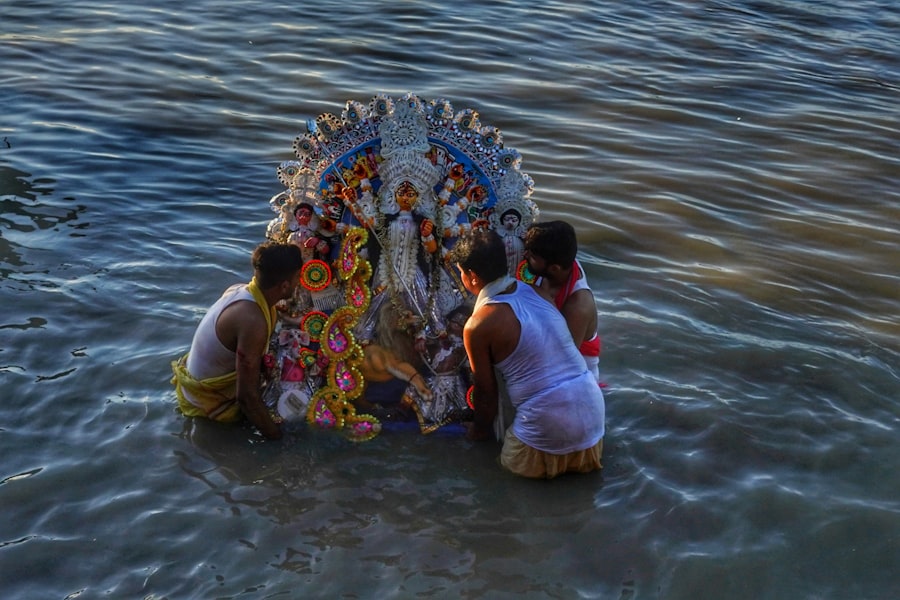The Vedic and Puranic traditions form the bedrock of Hindu religious thought and practice, representing two distinct yet interrelated phases of ancient Indian spirituality. The Vedic tradition, which emerged around 1500 BCE, is characterized by its sacred texts known as the Vedas, comprising four main collections: Rigveda, Samaveda, Yajurveda, and Atharvaveda. These texts encapsulate hymns, rituals, and philosophical discourses that reflect the early Indo-Aryan civilization’s worldview.
In contrast, the Puranic tradition, which developed later, around the first few centuries CE, encompasses a vast body of literature known as the Puranas. These texts serve to narrate the myths, legends, and genealogies of gods, heroes, and sages, thus providing a more accessible framework for understanding the divine and the cosmos. The interplay between these two traditions is significant in shaping the religious landscape of India.
While the Vedic texts emphasize ritualistic practices and the worship of natural forces personified as deities, the Puranas introduce a more narrative-driven approach to spirituality. They democratize religious knowledge by making it available to a broader audience beyond the priestly class. This evolution reflects a shift from a primarily ritualistic and sacrificial religion to one that embraces storytelling, moral lessons, and devotional practices.
The Vedic and Puranic traditions together create a rich tapestry of beliefs and practices that continue to influence millions of adherents today.
Key Takeaways
- Vedic and Puranic religious traditions are ancient and complex belief systems that have shaped Indian culture and society for thousands of years.
- The historical background of these traditions dates back to the Vedic period, with the Puranic traditions emerging later and incorporating elements of Vedic beliefs.
- Key deities and concepts in Vedic and Puranic traditions include gods such as Indra, Vishnu, and Shiva, as well as the concepts of karma, dharma, and moksha.
- Rituals and practices in these traditions include yajnas, puja, and meditation, which are performed to honor the deities and seek spiritual growth.
- The influence of Vedic and Puranic traditions on Indian culture and society can be seen in various aspects such as art, literature, music, and social customs, reflecting a deep spiritual and philosophical heritage.
- The contemporary relevance of Vedic and Puranic traditions lies in their continued impact on Indian spirituality, philosophy, and cultural identity, as well as their influence on global understanding of Hinduism and Indian traditions.
Historical Background of Vedic and Puranic Traditions
The Early Vedic Period: Rituals and Deities
During the early Vedic period, people lived a pastoral lifestyle, and rituals centered around fire sacrifices (yajnas) performed by priests (Brahmins) to appease deities associated with natural phenomena such as Agni (fire), Indra (thunder), and Varuna (cosmic order).
The Shift to Philosophical Inquiry
As time progressed into the later Vedic period (around 800-200 BCE), there was a notable shift in focus from ritualistic practices to philosophical inquiry.
The Emergence of Hindu Philosophy and the Puranic Tradition
The emergence of these texts laid the groundwork for various schools of thought within Hindu philosophy. In contrast, the Puranic tradition arose in a different socio-political milieu characterized by the rise of regional kingdoms and increased cultural exchanges. The Puranas were composed in response to this changing landscape, aiming to codify local beliefs and practices while integrating them into a broader Hindu framework.
Key Deities and Concepts in Vedic and Puranic Traditions

In the Vedic tradition, deities are often associated with natural elements and cosmic principles. For instance, Agni is revered as the god of fire and is central to Vedic rituals where offerings are made into the sacred flames. Indra, as the king of gods, embodies strength and valor, often depicted as a warrior who battles demons to protect cosmic order.
Varuna represents moral authority and cosmic law, emphasizing the importance of truth (rita) in maintaining harmony in the universe. These deities are not merely objects of worship; they symbolize fundamental aspects of existence that early Vedic society sought to understand and manipulate through ritual. The Puranic tradition expands upon these earlier deities while introducing new ones that resonate with popular devotion.
Vishnu emerges as a central figure in many Puranas, often depicted as a preserver who incarnates in various forms (avatars) such as Rama and Krishna to restore dharma (righteousness) on Earth. Shiva also gains prominence as both a creator and destroyer, embodying dualities that reflect the complexities of life. The Puranas further elaborate on concepts such as karma (the law of cause and effect), dharma (duty/righteousness), and moksha (liberation from the cycle of birth and death), providing a comprehensive framework for understanding human existence within a divine context.
Rituals and Practices in Vedic and Puranic Traditions
Rituals in the Vedic tradition are intricate and highly structured, often requiring extensive knowledge of hymns and precise execution by trained priests. The yajna is perhaps the most significant ritual, involving offerings made to deities through fire. These ceremonies are believed to invoke divine favor and ensure prosperity for individuals and communities alike.
The performance of rituals is not merely an act of devotion but is seen as a means to maintain cosmic order and harmony. The meticulous nature of these rituals reflects an understanding that every action has spiritual consequences. In contrast, Puranic rituals tend to be more accessible to lay practitioners.
They often include temple worship (puja), festivals celebrating various deities, and pilgrimages to sacred sites. The emphasis shifts from elaborate sacrifices to personal devotion (bhakti), where individuals can connect with the divine through prayer, chanting, and offerings. Festivals such as Diwali or Navaratri exemplify this shift; they celebrate divine narratives while fostering community participation.
The Puranas also encourage storytelling as a form of ritual practice, where reciting myths or engaging in dramatic reenactments serves both educational and devotional purposes.
Influence of Vedic and Puranic Traditions on Indian Culture and Society
The impact of Vedic and Puranic traditions on Indian culture is profound and multifaceted. From art and literature to philosophy and social norms, these traditions have shaped various aspects of life in India for millennia. The Vedas laid the foundation for classical Indian philosophy, influencing schools such as Vedanta and Samkhya that explore metaphysical questions about reality and consciousness.
This philosophical discourse has permeated various cultural expressions, including poetry, dance, and music. Moreover, the Puranas have played a crucial role in shaping regional identities within India. They often incorporate local deities and legends into their narratives, fostering a sense of belonging among diverse communities.
This adaptability has allowed Hinduism to flourish across different regions while maintaining core beliefs.
The narratives found in these texts have inspired countless artistic representations in sculpture, painting, and performance arts throughout Indian history.
Contemporary Relevance of Vedic and Puranic Traditions

In contemporary society, Vedic and Puranic traditions continue to resonate with millions around the world. The resurgence of interest in ancient wisdom has led many individuals to explore these texts for guidance on ethical living, spirituality, and personal growth. Modern interpretations often emphasize universal themes found within these traditions—such as compassion, justice, and interconnectedness—making them relevant in today’s globalized world.
Furthermore, contemporary movements within Hinduism often draw upon Vedic principles to address modern challenges such as environmental sustainability or social justice. The concept of dharma is frequently invoked in discussions about ethical responsibilities toward society and nature. Additionally, yoga practices rooted in Vedic philosophy have gained immense popularity worldwide as tools for physical well-being and spiritual exploration.
The narratives from the Puranas continue to inspire films, literature, and art forms that engage new generations with their timeless wisdom. In summary, both Vedic and Puranic traditions offer rich insights into human existence that transcend time and cultural boundaries. Their teachings remain vital for understanding not only individual spirituality but also collective identity within an ever-evolving society.
For a deeper understanding of the epistemological foundations of Vedic and Puranic religious traditions, one may find the article on “Understanding the Four Pramanas in Indian Philosophy” to be particularly enlightening. This article delves into the concept of pramanas, or sources of knowledge, which are crucial in shaping the beliefs and practices of these ancient religious traditions. By exploring the different ways in which knowledge is acquired and validated in Indian philosophy, readers can gain a more nuanced perspective on the philosophical underpinnings of Vedic and Puranic traditions. To read more on this topic, visit this link.
FAQs
What are Vedic and Puranic religious traditions?
Vedic and Puranic religious traditions are ancient religious traditions that originated in the Indian subcontinent. The Vedic tradition is based on the Vedas, a collection of ancient sacred texts, while the Puranic tradition is based on the Puranas, a genre of ancient Hindu texts.
What are the Vedas?
The Vedas are a collection of ancient sacred texts that form the foundation of the Vedic religious tradition. They are considered to be the oldest scriptures of Hinduism and are composed in Sanskrit.
What are the Puranas?
The Puranas are a genre of ancient Hindu texts that form the basis of the Puranic religious tradition. They contain a wide range of topics, including cosmology, mythology, genealogies of gods, legends, and traditional history.
What are the main deities in Vedic and Puranic traditions?
The main deities in Vedic and Puranic traditions include Brahma, Vishnu, Shiva, and Devi (the goddess). These deities are central to the religious beliefs and practices of followers of these traditions.
What are the key religious practices in Vedic and Puranic traditions?
Key religious practices in Vedic and Puranic traditions include rituals, sacrifices, worship, meditation, and the recitation of sacred texts. These practices are aimed at seeking the favor of the deities and achieving spiritual growth.
How have Vedic and Puranic traditions influenced Indian culture and society?
Vedic and Puranic traditions have had a profound influence on Indian culture and society, shaping religious beliefs, rituals, art, literature, and social customs. These traditions continue to be an integral part of the cultural and religious fabric of India.























+ There are no comments
Add yours